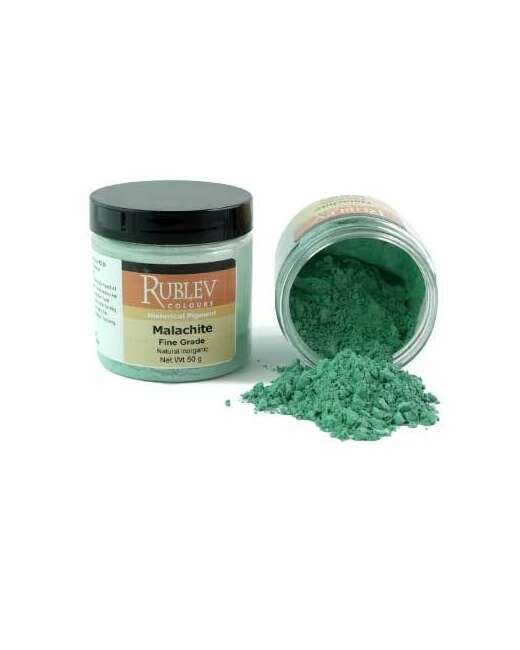Vivianite 50g
| Pigment Names | |||||||
| Common Names (pigment): | English: blue ochre, blue ocher French: Ocre martiale bleue German: blauer Oker Italian: ocre blu Spanish: ocre azul | ||||||
| Common Names (mineral): | English: Vivianite French: Vivianite German: Vivianit Italian: Vivianita Spanish: Vivianita | ||||||
| Synonyms: | angelardite, anglarite (of Berthier), anglarite (of Kobell), blue iron earth, glaucosiderite, mullicite, native Prussian blue, odontolite, paravivianite, phosphate of iron | ||||||
| Nomenclature: |
| ||||||
| Pigment Information | |
| Color: | Blue |
| Pigment Classification: | Natural Inorganic |
| Colour Index: | Not Listed |
| Chemical Name: | Hydrated Iron Phosphate |
| Chemical Formula: | Fe3+2(PO4)2-8(H2O) |
| CAS No.: | 14567-67-0 |
| Series No.: | 7 |
| ASTM Lightfastness | |
| Acrylic: | Not Listed |
| Oil: | Not Listed |
| Watercolor: | Not Listed |
| Physical Properties | |
| Particle Size (mean): | 12 microns |
| Density: | 2.60 g/cm3 |
| Hardness: | 5.0–5.6 |
| Refractive Index: | 1.50–2.0 |
| Oil Absorption: | 35 grams oil / 100 grams pigment |
| Health and Safety | There are no acute or known chronic health hazards associated with the anticipated use of this product (most chemicals are not fully tested for chronic toxicity). Always protect yourself against potentially unknown chronic hazards of this and other chemical products by keeping them out of your body. Do this by avoiding ingestion, excessive skin contact, and inhalation of spraying mists, sanding dusts and vapors from heating. Conforms to ASTM D-4236. |
For a detailed explanation of the terms in the table above, please visit Composition and Permanence.
Origin and History of Use
Vivianite, named after the English mineralogist F. G. Vivian, is a rare mineral of secondary origin associated with pyrite in copper and tin veins, and is a hydrated iron phosphate of a blue to green color.
Vivianite has rarely been found on European easel paintings, but it has been identified in medieval paintings in Germany and in English medieval polychromy. The School of Cologne used it to depict skies in the 13th and 14th century.
Source
Vivianite is found principally in two environments: In the oxidized upper layers of ore deposits, where it may appear as dark indigo, blue-black, or green crystals. It is also found in organic rich environments often lining the inside of ancient mollusk shells, but sometimes associated with bones, decaying wood and other organic material. Vivianite forms radiating clusters of acicular (needle-like), prismatic or fibrous bluish-green crystals in association with hematite, siderite or anapaite. Mineral from the latter environment is sometimes collected for use as pigment, but in practice it is more frequently gathered from ore deposits, such as peat bogs and marshy-lakes. Extracting soft, friable vivianite concretions from viscous, dense clayey soil is time-consuming. Once obtained it is necessary to thoroughly wash it to remove clay and organic residue from each grain of vivianite. The labor expended in this operation is rewarded by a high-quality end product. Vivianite is generally stable and dark blue or green in color, though the mineral may be colorless when first exposed. This color transformation is a special feature of vivianite found in peat bogs.
At present the most significant reserves of vivianite in Russia are in the Kudinovskoye layer of bog ores near Moscow. Deposits of vivianite are also found in Bolivia; Gervais, Brazil; Colorado, U.S.; Cornwall, England; Crimea, Ukraine; Germany; and Serbia. We obtain our vivianite from bog ore deposits in the Moscow area.
Permanence and Compatibility
Vivianite is recognized to generally be stable, but there have been instances were it was observed to alter from its blue hue to a yellow color. The mineral's color change from colorless to blue on initial exposure is due to increased ferric ion concentrations, and so it has been established that mechanical and chemical processing can produce a change in color.
Oil Absorption and Grinding
Vivianite employed in oil medium has been improperly identified as natural Prussian blue. No data has been published on the oil absorption and grinding qualities of vivianite.
Toxicity
Vivianite is not considered to be toxic, but care should be used in handling the dry powder pigment so as not to inhale the dust.
For more information on how to handle pigments safely, please visit How to Safely Handle Art Materials and Pigments.
| SKU | 410-2005 |
|---|---|
| Brand | Rublev Colours |
| Vendor | Natural Pigments |
| Processing Time | Usually ships the next business day. |
| Size | 50 g jar |
| Color | Blue |






